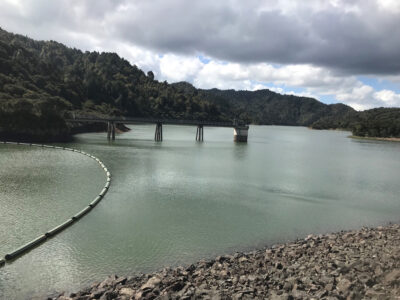
Dam levels have risen past 90 per cent for the first time since February 4, 2019.
Recent rainfall events have had a positive impact on Auckland’s water storage.
A Watercare spokesperson said at the moment, with Auckland still recovering from 2020’s severe drought, it is minimising production at its Ardmore Water Treatment Plant, which treats water from the four Hūnua dams, and maximising production at its Waikato water treatment plants, where it treats water from the Waikato River.
This eases the pressure on the Hūnua dams, allowing them to fill up as much as possible when it rains.
Since restrictions were put in place in May 2020 Watercare has:
- Completed the Pukekohe East reservoir, a key project enabling its Waikato Water Treatment Plant to treat up to 175 million litres a day (MLD)
- Completed the Waikato 50 plant in record time, taking its peak production from the Waikato River to 225 million litres a day
- Built a new Pukekohe Water Treatment Plant, which treats up to 5MLD
- Built the first stage of Papakura Water Treatment Plant, which treats up to 6MLD
- Upgraded Onehunga Water Treatment Plant, boosting treatment capacity by 4MLD
- Carried out acoustic leak detection on more than 5500 kilometres of Watercare’s water network to find and fix invisible leaks. This has saved an estimated 9MLD.
- At the same time, Aucklanders have saved billions of litres of water.
A large proportion of Auckland’s drinking water comes from 10 dams in Auckland’s Hūnua and Waitākere ranges.
In February 2021, the 10th and smallest dam, Hays Creek Dam, was recently reconnected to the network boosting Auckland’s capacity initially by six million litres a day and by up to 12 million litres in the second half of 2021.
“Recent rain has helped replenish our dams following the drought of 2020, but our total storage is still sitting below the historical average,” Watercare said.
Dam storage on Monday sat at 91.09 per cent (90.82 per cent on Sunday), just shy of the 91.1 per cent which is normal for this time of year.
Sunday’s consumption was 364MLD against a target for October of 420MLD or less. Sunday’s 7-day rolling average was 388MLD.
Watercare said although Auckland’s water supply is currently stable, stage one outdoor restrictions remain in place.
“As a result, we will be reviewing our position on water restrictions,” Watercare said.
“The additional factors we will consider are the weather forecasts for spring and summer; production volumes at our treatment plants and customer use.”
A recommendation by Watercare to lift Auckland’s outdoor water restrictions will be considered by the Auckland Council’s governing body at an extraordinary meeting tomorrow [October 21].
The restrictions – which currently prevent the use of sprinklers but allow hoses fitted with trigger nozzles – have been in place since May 16, 2020 in response to the region’s record-breaking drought.
Auckland Mayor Phil Goff says he will be advocating for the restrictions to be lifted, which if approved, will take place on Saturday, October 23.










